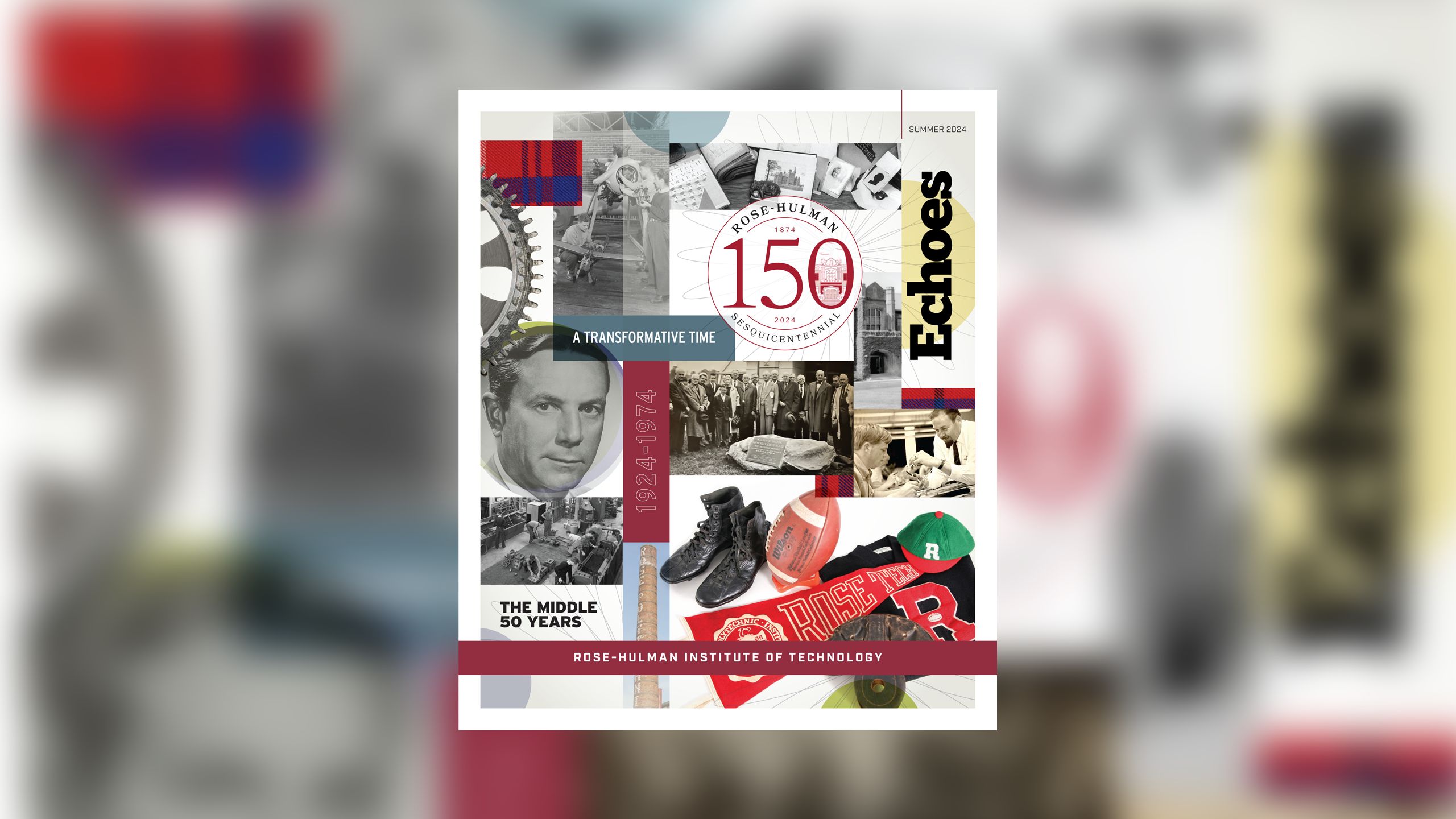
Contents
COVER STORY
Growing Strong
Read the full issue
Read more campus and alumni stories with the full digital version of Echoes.
Solar Spectacle
CAMPUS GUESTS ENJOY UNIQUE ECLIPSE EXPERIENCE

This spring’s total solar eclipse may have lasted less than four minutes, but its awe-inspiring splendor left a lasting impression on the more than 1,100 students, alumni, faculty, staff, and their family and friends who witnessed this unique event on campus.
“Science, and especially astronomy, put on quite a show,” said Assistant Professor of Physics and Optical Engineering Elizabeth Melton (PH/MA, 2015), PhD, whose role as Director of Rose-Hulman’s Oakley Observatory included organizing educational activities for the campus event. “It was quite an experience and a special day that we (Rose-Hulman) could share with so many others.”

The Office of Alumni Relations reports that approximately 500 alumni had registered to attend the eclipse viewing party, taking advantage of the opportunity to take close-up views of the historic event through high-powered telescopes in Oakley Observatory and other smaller portable telescopes scattered around Cook Stadium. Guests also could watch elements of the eclipse unfold from a broadcast shown on a large video scoreboard at the stadium.

The eclipse’s path of totality put Rose-Hulman in a prime location for guests to put on Rose-branded safety solar-viewing glasses, look skyward, and witness the historic event.
Making a trek from Chicago to join in the fun were Walter Flood (CE, 1975), his son, Walt Flood IV (CE, 2003), two grandchildren, and a niece.
“Any day that I can spend with my son and grandchildren is special, but this made it even more grand,” said Walter.

Walt added, “Upon learning that Rose-Hulman was inviting alumni to this special eclipse- viewing event, I just knew we had to be here. Rose is just a special place with special people. This event and day made it even more unique.”
Recently retired Mechanical Engineering Professor Thom Adams (ME, 1990), PhD, said, “It’s such a serene occurrence when the sun, moon, and Earth are in such perfect alignment, and we get to witness it right before our very eyes. Science is so cool.” He is hoping to view another solar eclipse during 2028 while living in Spain after retirement.


From the President
Stories play a critical role in shaping our beliefs, our values, and our culture. We use them to educate, to entertain, to inspire, and they provide a way to simply make sense of the world around us. Our most recent Commencement was a meaningful time to celebrate some of our stories. We reviewed the stories of the members of the Class of 2024, stories that led them to Rose-Hulman to share a chapter in our Institute’s own story.
Our Institute’s story consists of 150 years of stories that have brought Rose-Hulman to this sesquicentennial celebration. It seems a fitting time to reflect on the remarkable journey that has brought us to this milestone. Our Institute’s rich history is filled with stories of innovation, entrepreneurship, and discovery that have shaped not only Rose-Hulman Institute of Technology, but also the world around us.
Our sesquicentennial celebration is more than just a commemoration of the past; it is an opportunity to project forward and envision the future. We have an exciting lineup of events planned nationwide this year, bringing our alumni together to celebrate this significant milestone and envision the future together.
One of the highlights of our sesquicentennial celebration will be the first Rose Gala, a formal event taking place during Homecoming weekend at the new Terre Haute Convention Center. This event will include cocktails, dinner, and live entertainment. More details about how to purchase tickets will be coming soon. We hope you will join us for an evening of celebration and connection.
As we reflect on the 150 years of Rose-Hulman, we recall some of the unprecedented challenges we have faced and overcome together. Our resilience and determination, honed through shared experiences, have prepared us well for the future. These skills will continue to guide us as we navigate new challenges and opportunities.
Our alumni have always pushed the boundaries of what is possible, contributing to countless advancements. They have been instrumental in breakthroughs that have transformed industries and improved lives, from color television and semiconductors to medical technology and space exploration. Their achievements are a testament to the enduring values of innovation, collaboration, and perseverance that define Rose-Hulman.
As we spotlight Rose-Hulman’s sesquicentennial stories in Echoes and on our website (rose-hulman.edu/150), I hope they fill you with as much wonder and pride as I experience when I read them. These stories are a powerful reminder of the impact our community has had and will continue to have on the world. The sesquicentennial celebration is more than a birthday—it is a moment to reaffirm our commitment to the values that have sustained us for 150 years. It is a time to dream big, take
risks, and challenge ourselves, sustaining our legacy of excellence and innovation.
As we look ahead, one can only imagine the remarkable stories that will unfold in the years to come. What will we achieve that will be celebrated 150 years from now? While we cannot predict the future, we remain confident that the legacy of Rose-Hulman will continue to thrive through the continued amazing contributions of our alumni, students, and community.
I look forward to following the stories of our new Class of 2024 and everyone else who shares a connection with Rose-Hulman. Together, we will continue to have a positive impact and
extend the powerful legacy of our institution.
Here’s to another 150 years of remarkable achievements and inspiring stories.



The special campus Sesquicentennial Celebration featured President Robert A. Coons, Provost Rick Stamper, Dean of Students Erik Hayes, and Student Government Association President Courtney Valmore.
The special campus Sesquicentennial Celebration featured President Robert A. Coons, Provost Rick Stamper, Dean of Students Erik Hayes, and Student Government Association President Courtney Valmore.

Over more than two years, the Institute reached out to more than 1,000 stakeholders—including alumni, corporations, parents, faculty and staff, and current students—to collaborate and provide input for the Advancing by Design Strategic Plan.
Over more than two years, the Institute reached out to more than 1,000 stakeholders—including alumni, corporations, parents, faculty and staff, and current students—to collaborate and provide input for the Advancing by Design Strategic Plan.

Our mission will continue to provide our students with the world's best undergraduate STEM education in an environment of individual attention and support.
Our mission will continue to provide our students with the world's best undergraduate STEM education in an environment of individual attention and support.

“Let’s seize this moment. Let’s challenge ourselves to think differently, to act boldly, and to change the world for the better.” — Darin Moody (CHE, 1987) Rose-Hulman Trustee
“Let’s seize this moment. Let’s challenge ourselves to think differently, to act boldly, and to change the world for the better.” — Darin Moody (CHE, 1987) Rose-Hulman Trustee

Our graduates will continue to be inspired and prepared for lives of purpose and success, defining and solving the problems of a complex global society.
Our graduates will continue to be inspired and prepared for lives of purpose and success, defining and solving the problems of a complex global society.
SETTING THE STAGE FOR THE FUTURE
Celebrating 150 Years of Progress While Advancing by Design
As Rose-Hulman celebrates its 150-year legacy, the stakeholder-focused “Advanced by Design” Strategic Plan sets the framework throughout the next decade, committing the Institute to continue being a leader in undergraduate science, engineering, and mathematics education.
It is bold. It is visionary.
It is comprehensive.
“As we look to the future, it is now our moment to collectively carry forward the spirit of innovation, dedication, and community that has defined Rose-Hulman for 150 years,” says President Robert A. Coons while announcing aspects of the strategic plan at a special campus Sesquicentennial Celebration this spring. “Together, we will continue to advance by design, shaping a future that not only meets but exceeds our wildest dreams.”
As the Institute looks ahead, Coons highlighted several significant achievements from its storied history:
- The college’s founding in 1874 by entrepreneur, business leader, and philanthropist Chauncey Rose.
- The Rose Show, Rose-Hulman’s version of the World’s Fair, showcased student ingenuity and creativity to the community.
- Welcoming the first co-ed class of students in 1995, embracing a richer, more diverse community of scholars.
- Being ranked No. 1 in undergraduate engineering education for the past 25 years, a testament to the unwavering dedication and talent of the faculty, staff, students, and alumni.
“As we stand on the shoulders of this remarkable legacy, I am convinced that our best days are still ahead,” remarks Coons, who has been a campus leader for 35 years and president since 2018. “This plan is a reflection of our collective vision—a commitment to not just sustain, but to elevate our legacy, ensuring that innovation, sustainability, and leadership feed into our mission to provide the world’s best undergraduate STEM education in an environment of individual attention and support.”
Board of Trustees member Darin Moody (CHE, 1987) says Advancing by Design provides a roadmap for transformation that will propel the Institute into a new era of innovation and impact. After all, Rose-Hulman has had a commitment to continuous improvement, a dedication to lifelong learning, and a relentless pursuit of excellence.
“Let’s seize this moment. Let’s challenge ourselves to think differently, to act boldly, and to change the world for the better,” he says. “As we honor our past, we need to embrace the future with open arms. Change is inevitable, but it’s how we respond to it that defines us.”
Provost and Vice President of Academic Affairs Rick Stamper (ME, 1985), PhD, adds, “Engineers are not in the business of predicting the future. We’re in the business of creating the future.”
Over more than two years, the Institute reached out to more than 1,000 stakeholders—including alumni, corporations, parents, faculty and staff, and current students—to collaborate and provide input for the Advancing by Design Strategic Plan. They were asked to consider how Rose-Hulman should rise to the challenge of the future by enhancing our offerings to students, creating new opportunities for students, and defining and ensuring student success to becoming the educational institute of choice throughout the world.
“We had this magic of all these people coming together,” says Associate Professor of Chemistry and Biochemistry Stephanie Poland, PhD. “As we got all these new ideas coming together, it helped us recognize the needs of society. That’s exactly what scientists and engineers should be doing.”
The strategic plan elements support the Institute’s core mission of providing students with the world’s best under-graduate science, engineering, and mathematics education in an environment of individual attention and support.
“We are fundamentally changing the way [students] think about the world and how they interact with it,” says Assistant Professor of Mechanical Engineering Michael Canino, PhD.
The Sesquicentennial Celebration featured contributions from Dean of Students and Vice President for Student Affairs Erik Hayes (BSME, 1997/MSME, 2001) and past Student Government Association President Courtney Valmore (CHE, 2024). Faculty featured in a video on developing the Advancing by Design Strategic Plan were Craig Downing, PhD, Associate Dean of Lifelong Learning and Head of the Department of Engineering Management; Sriram Mohan, PhD, Head of the Department of Electrical and Computer Engineering; Ella Ingram, PhD, Professor of Biology and Biomedical Engineering; and Adam Nolte, PhD, Professor of Chemical Engineering.
"ADVANCING BY DESIGN" THEMES:
- Infuse Sustainability into the Rose-Hulman Education and Culture
- Instill a Mindset of Innovation, Discovery, and Entrepreneurship
- Prepare Students to be Leaders in a Global and Diverse Society
- Increase the Affordability and Value of a Rose-Hulman Education
View aspects of the full plan:
Rose-Hulman.edu/StrategicPlan
Campus Cherishes the Past, Looks to Future

Students, faculty, staff, and alumni kicked off the year-long Sesquicentennial Celebration with a campus event that featured historical highlights, giveaways, a 150-foot submarine sandwich, and photo opportunities with Rosie, the Institute’s lovable elephant mascot. Afterward, renowned educator, author, and nationally known internet personality Hank Green answered questions as part of a new student leadership development series supported by John Swearingen (BSCHE, 1981/HDENG, 2024) and his wife, Anne.


INOVATION GROVE
Planting Seeds for Entrepreneurship
Hulman Farm Site to Host Rose-Hulman Ventures, Transformative Local Medical Partnership

The Innovation Grove district on the former Hulman Farm property adjacent to the main campus will feature a new location for Rose-Hulman Ventures (left side of architectural rendering) and a state-of-the-art outpatient surgery center for the Indiana Joint Replacement Institute (right side).
The Innovation Grove district on the former Hulman Farm property adjacent to the main campus will feature a new location for Rose-Hulman Ventures (left side of architectural rendering) and a state-of-the-art outpatient surgery center for the Indiana Joint Replacement Institute (right side).
Development of a campus entrepreneurial ecosystem is underway with seeds being planted for an Innovation Grove district featuring amenities that will provide students with additional internships and hands-on experiences to gain the skills needed to thrive in a rapidly changing world.
It is one of the centerpieces of the “Advancing by Design” Strategic Plan.
The site on the former Hulman Farm property adjacent to the main campus will feature the relocation of Rose-Hulman Ventures (RHV), space for Rose-Hulman’s new entrepreneurial Sawmill Society network, and a transformative partnership between the Institute, Union Health, and Indiana Joint Replacement Institute (IJRI). There’s also a long-term vision to further leverage Rose-Hulman faculty expertise, student ingenuity, and industry partnerships to fuel economic growth in
the Wabash Valley.
“As we continue to identify ways to strengthen our presence globally, our vision is that Innovation Grove will be a thriving, self-sustaining entrepreneurial center that houses advanced labs and testing facilities, a greatly expanded client base, and, most importantly, valuable hands-on and immersive learning opportunities that enhance our students’ classroom and laboratory educational experiences,” says President Robert A. Coons.
RHV is an engineering service provider specializing in innovation stage projects that blends experienced engineers and project managers with student interns to solve real-world problems with industry partners. It is currently located on the Institute’s South Campus, several miles away from campus.
Fostering Health Care Innovation
The Rose-Hulman, Union Health, and the IJRI partnership will drive new technological advancements in the health care industry, provide hands-on experience for students, and bring patients from all over the Midwest to Terre Haute for orthopedic joint replacement surgeries in a 40,000-square-foot state-of-the-art outpatient surgery center and medical office that will be adjacent to Rose-Hulman Venture’s main building in Innovation Grove.
IJRI Chief Executive Officer Michael Meneghini, MD, a 1995 civil engineering alum, has partnered with Rose-Hulman faculty and RHV in the past on orthopedics research and development—laying the foundation for this latest partnership.
“This exciting venture is a unique collaboration fostering innovation in biomedical engineering education, research and development and the highest quality patient care in hip and knee replacement,” says Meneghini. “This will provide a unique destination for students, industry partners, engineers, surgeons, health care professionals, and patients to experience
the latest advancements in orthopedic hip and knee replacement surgery.”
IJRI’s two-story facility will have up to four operating rooms, 14 recovery beds, X-ray, physical therapy, and approximately 20-24 exam rooms.
The partnership brings together nationally recognized leaders in undergraduate STEM education and joint replacement surgery to leverage their respective strengths. Students will gain real-world experience in biomedical device development, providing a unique environment to foster innovation and research in the field and promote the highest quality patient care.
“This new pathway will allow the best and brightest students in STEM to collaborate alongside skilled orthopedic surgeons,” states President/CEO of Union Health Steve Holman.
Funding to accomplish Innovation Grove’s goals will come from various private philanthropic sources along
with federal, state, and community support. Efforts are currently underway to secure additional grant funding to further the longer-term vision.







THE MIDDLE 50 YEARS
INSTITUTE MATURES AND PROSPERS INTO ELITE STEM COLLEGE

After moving to its present location in 1922, Rose Polytechnic Institute settled into its new country home to enjoy the next 50 years of its history. This period, from 1924-1974, would be filled with fiscal challenges, expansion of student enrollment and campus buildings, technological adaptation, and strengthening of the strenuous academic programs that would become a hallmark of the college and a guiding force for its alumni to make a difference in their STEM career fields.
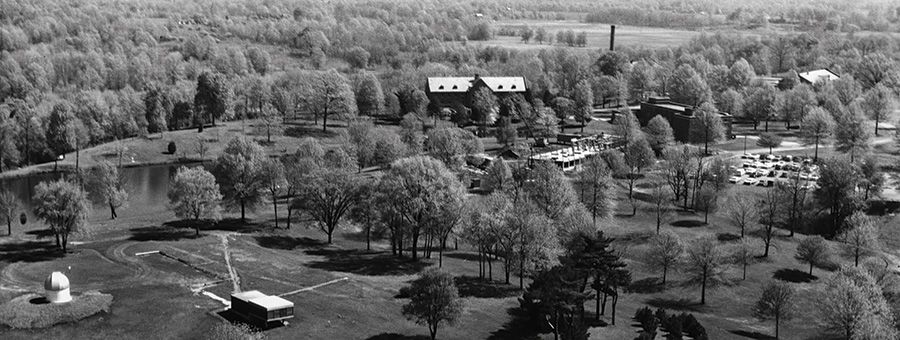
An aerial photo showcases the early stages of a growing campus with Deming Hall (middle) and other residence halls, the Main Building (upper right), and Lynn Reeder Observatory (lower left).
An aerial photo showcases the early stages of a growing campus with Deming Hall (middle) and other residence halls, the Main Building (upper right), and Lynn Reeder Observatory (lower left).
The end of this era also brought forth a new name, Rose-Hulman Institute of Technology, following the generosity of Anton Hulman Jr. and his wife, Mary Fendrich Hulman, in turning over assets of the Hulman family’s foundation—valued at more than $11 million—to the Institute in 1971 to continue their family’s tradition of philanthropy toward the college. There had been other contributions by the Hulmans throughout the years, including support to build the first formal student union building.
This was a time of transformational change for the Institute—one of several throughout its 150-year history. The campus landscape expanded with new buildings for academics, residence life, and student services; enrollment slowly grew to exceed 1,000 students; and several new academic programs were added to the curriculum to meet the technical changes in society and growing demand for STEM graduates.
Rose’s prestige also grew as the college started attracting students from throughout the country and world. Many of these students had strong academic backgrounds. In fact, by the mid-1970s, more than 90% of the Institute’s student body had been ranked in the top 5% of their high school graduating classes.
These students were challenged by quality professors in every academic department, including an expanded humanities and social sciences area emphasized by President John Logan. Notable professors included Herman Moench, who had a glorious 56-year career as an electrical engineering educator and Institute administrator (twice serving as interim president); John L. Bloxsome, an English professor for 41 years who wrote a book chronicling Rose’s first 100-year history; Darrell Criss, computer science; Clarence P. “Doc” Sousley, a faculty member for 24 years; Ted Palmer in mathematics; Oran Knudsen in chemical engineering; Irv Hooper in mechanical engineering; Robert McCormick, civil engineering; and C. Leroy Mason, physics.
And, of course, the staff increased to provide students with additional services and support. Former professor Ralph Ross became the first full-time Dean of Students, assisted by Jess Lucas.
Throughout this period, the personal touch continued to be a foundational spirit within the campus community.

Tony Hulman (top, left) and his wife, Mary, turned over the family foundation's assets to President John Logan and Board of Managers Chair Benjamin Cox--a significant gift to the Institute.
Tony Hulman (top, left) and his wife, Mary, turned over the family foundation's assets to President John Logan and Board of Managers Chair Benjamin Cox--a significant gift to the Institute.
A BUILDING BOOM EXPANDS ACADEMIC, RESIDENCE LIFE & STUDENT SERVICES
The Institute’s landscape expanded to provide the growing need of providing classrooms, laboratories, residence life, and student services as enrollment expanded at steady rates, starting in the late 1950s.
The first residence hall, Deming Hall, was opened in the fall of 1926, and also served as a student center and dining area, along with having several small classrooms.

Residence life opportunities expanded with the additions of Deming Hall (1926), Baur-Sames-Bogart Hall (1956), Speed Hall (1963), and Blumberg, Mees and Scharpenberg Halls (1968).
Residence life opportunities expanded with the additions of Deming Hall (1926), Baur-Sames-Bogart Hall (1956), Speed Hall (1963), and Blumberg, Mees and Scharpenberg Halls (1968).
A building boom commenced in the late 1940s as the campus started spreading across its 123-acre site. Twenty old Navy barracks were erected on campus in 1946 for single and married student residence housing and two years later a surplus B-29 airplane hangar, donated by 1911 architecture alumnus Wilbur Shook, became a fieldhouse for athletics and recreation on campus. Its construction allowed for the former gymnasium on the top floor of the Main Building (now Moench Hall) to be remodeled into an auditorium for large campus meetings, special events, drama club performances, and club activities.

The campus’ first student center was opened in 1954, with spaces for students to gather and relax between classes. It was later replaced by a formal student union in 1966 with a dining room for students living on campus, a bookstore, and rooms for a growing list of student organizations.
The following residence halls were constructed to provide on-campus housing for the growing student population:
- Baur-Sames-Bogart Hall–1956
- Speed Hall—1963
- Blumberg, Mees, and Scharpenberg Halls—1968
Three social fraternities—Triangle, Phi Gamma Delta, and Delta Sigma Phi—moved onto the east side of campus.
Crapo Hall was opened in December of 1970 to provide additional classrooms for growing academic programs, especially the need for more foundational mathematics classes.
BACK TO THE FUTURE: THE ROSE SHOW
World’s fairs were in their heyday in the early 20th century, thrilling crowds with the wonders of the maturing industrial age. By 1927, Rose Polytechnic leaders chose to start their own miniature version of this global phenomenon, calling it The Rose Show, to impress the public with the remarkable work taking place by students on campus. Every two years from 1928 to 1940, this popular public event featured exhibits from each of the Institute’s academic departments and student clubs, along with outside companies and organizations.

The early shows took place over three days and attracted thousands of visitors to campus. The first featured 225 exhibits and attracted 3,486 paid guests. By 1932, attendance reached its peak with 6,765 people visiting 285 exhibits. Attendance remained well over 5,000 until the last show of this original period.
Featured exhibits from early Rose Shows included a modern sewage treatment plant, samples of X-rays and amplifiers, “Edisonia” (historical relics loaned by Thomas Edison), and a “Love-O-Meter.”
For unknown reasons, perhaps due to World War II, The Rose Show disappeared after 1940 and—with the exception of a one-day “Little Rose Show” in 1952—would not return until the Institute’s centennial year of 1974. It would then appear intermittently for the next 27 years and has resumed again as an annual display of student projects, attended by campus and community guests.
Learn more about the current Rose Show at
rose-hulman.edu/roseshow.
ACADEMIC PROGRAMS MEET GROWING TECH NEEDS
Mechanical engineering was the only major offered at Rose Polytechnic Institute during its early formative years, but that academic portfolio steadily expanded to meet the growing need of STEM professionals for America’s technological revolution of the 1950s, ’60s, and ’70s.
Degrees in chemistry, mathematics, and physics were added to the curriculum in 1958 with biological engineering following in 1966.
The purchase of the college’s first computer in the fall of 1960, under the leadership of Darrell Criss, PhD, provided a foundation for computer science to be added to the curriculum in 1968, within the Department of Mathematics.
Meanwhile, a master’s degree was adapted in the early 1930s, even though records show that the Institute presented its first master’s degree in 1892 to Toro Tsuiji, the son of a member of Japan’s ruling legislature.
OPERATION CATAPULT INTRODUCES STUDENTS TO STEM, ROSE
The summer of 1967 brought the first group of rising high school seniors to campus for the pilot year of the new Operation Catapult summer STEM camp experience. The project-oriented program was popular from the start, with 67 students participating that first summer (higher than the original 40-student goal). Besides allowing students to study and do research in a STEM area of interest, the program also gave students a look at college life and an introduction to Rose-Hulman. It was founded by Director of Admissions Paul Headdy and math professor/alumnus Alfred Schmidt (ME, 1949).

After more than 50 years, Operation Catapult may now be the oldest of its kind in the country and attracts students from throughout the country and world. They work in teams with a faculty mentor to complete a variety of hands-on projects that could be pulled from the day’s headlines: autonomous vehicles, e-commerce, biofuels, and material sciences, to name just a few.
Learn more about Operation Catapult at
rose-hulman.edu/catapult.
WHAT'S IN A NAME
You may be familiar with the institution and buildings bearing their names, but do you really know about these influential people in Rose-Hulman history?
Herman Moench
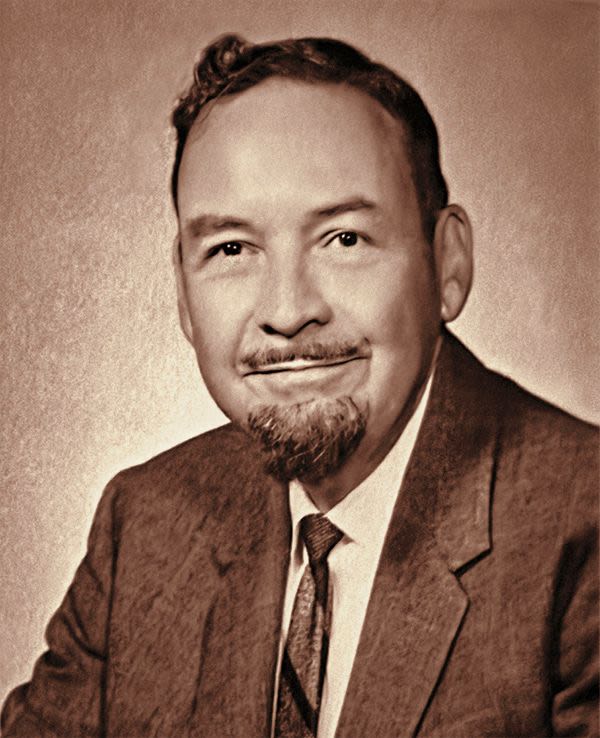
This memorable educator—affectionately known as “The Master Teacher”—spanned nearly all this 50-year era in Institute history. First, Moench was on campus as a student, earning an electrical engineering degree with high academic honors, in 1929. Then he had a distinguished 56-year career as an instructor, professor, and administrator at his beloved alma mater before retiring in 1986. He twice served as acting president (1958 and 1961-62) and was Dean of Faculty (1962-65) and Senior Vice President/professor (1966-86). Moench’s numerous honors included an outstanding teaching award from the American Society of Engineering Education and being Engineer of the Year from the Indiana Society of Professional Engineers. It’s no wonder that Rose-Hulman’s main education building was named in his honor in 1977 and the Moench Distinguished Senior Commendation is presented annually at Commencement.
John Logan

Rose-Hulman had remarkable growth in enrollment (doubling to slightly more than 1,000 students), facility improvement, and academic prestige throughout Logan’s 14-year tenure as Rose president (1962-75). He emphasized a “liberal education in engineering and science” and helped bring additional financial resources to increase the Institute’s faculty, especially in areas of the humanities and social sciences. Logan also was a strong advocate
for expanding student organizations, intramurals, and athletics. Major capital improvement projects completed under his leadership included the Blumberg, Mees, and Sharpenberg residence halls, Hulman Student Union, Crapo Hall, and the Learning Resource Center (later was named in his honor).
Tony Hulman

Before becoming a successful Terre Haute businessman and philanthropist whose ownership helped turn the Indianapolis Motor Speedway into the Racing Capital of the World, Hulman served a brief stint as coach of the freshman football team at Rose Polytechnic Institute. He also carried on the Hulman family’s long relationship with the Institute by being a member of the Board of Managers and then with his wife, Mary, transferred all Hulman Foundation assets to the Institute, a gift estimated to have a $11 million value, as well as many other family contributions throughout the years. The college’s name was changed to Rose-Hulman Institute of Technology in recognition of this generosity. The Hulman family’s involvement with Rose continues today with Tony’s grandson, Tony George (HDENG, 2003), serving as a trustee.
Phil Brown

There may not have been a sport that Brown couldn’t coach, but the football gridiron is where he had his greatest success in leading the Fightin’ Engineers. Two of his teams have had the only undefeated seasons in Rose history (7-0 in 1941 and 8-0 in 1958) and he was named an All-American Coach in 1930 by the Cincinnati Enquirer. His 1958 team may have been led by Associated Press Little College All-American running back Carl “Rocky” Herakovich (CE, 1959), but it also had a resilient defense, outscoring the opposition by a 270-31 margin and allowing just 24 completed passes during the entire season. Overall, Brown had a 99-109-7 record in 31 seasons. The Institute’s football field was named in Brown’s honor in 1969 and he was inducted into the Indiana Football Hall of Fame in 1985.
HISTORICAL TIMELINE
1924-1974
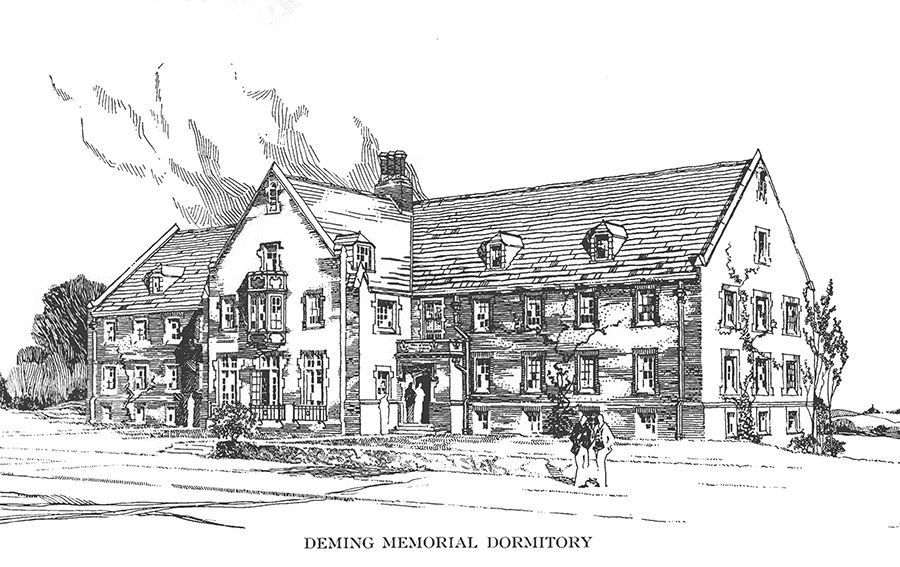
AUGUST, 1926
Deming Hall opened as the Institute’s first residence hall, as well as being a student center, dining area, and having several small classrooms; construction cost was $100,000.
JUNE, 1927
Radio station WRPI-AM began broadcasting on campus.

SPRING, 1928
Community residents came to campus to view the first Rose Show scientific open house; the event would become a popular annual event, attracting hundreds of guests to view Rose Poly’s version of the World’s Fair.
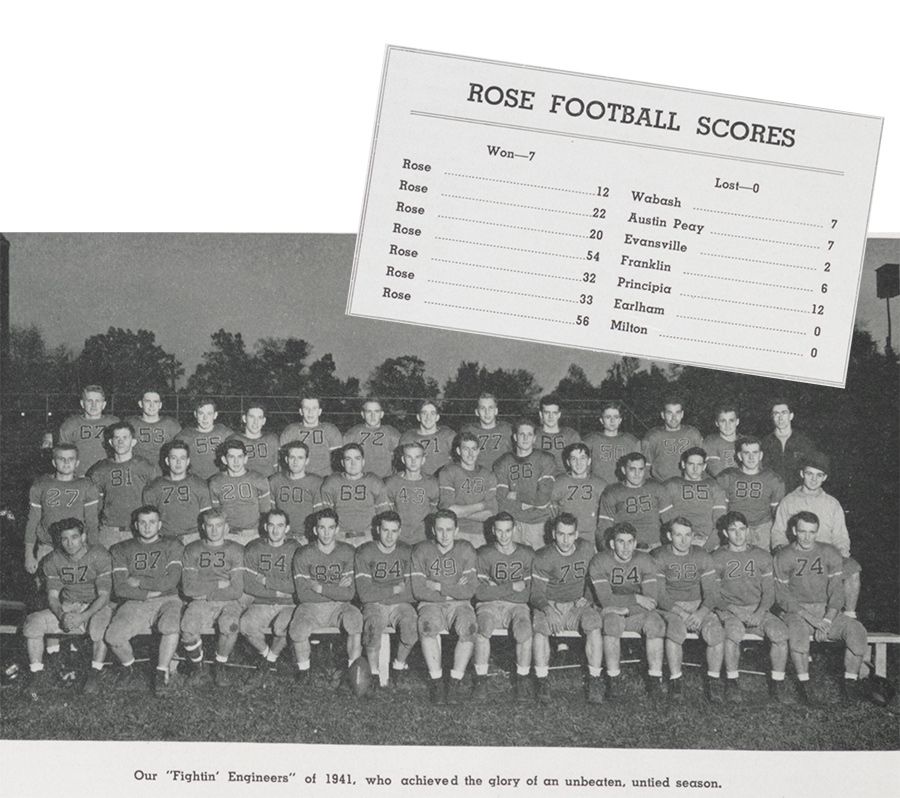
FALL 1941
The football team had its first undefeated season in Rose history with a 7-0 record; team only allowed 34 points, ending the season with two straight shutouts.

1946
Twenty old Navy barracks were erected on campus for single and married student residence housing.

FALL, 1948
Wilbur Shook (BSARCH, 1911/HDENG, 1956) donated a surplus B-29 airplane hangar that became a fieldhouse for athletics and student recreation on campus; building was later named Shook Fieldhouse in 1961 to honor his many contributions to the Institute.
1950
The former gymnasium (top floor of the Main Building) was remodeled into an auditorium for large campus meetings, special events, drama club performances, and club activities.

1954
An Alumni Association was formed to include alumni, the The campus’ first formal student center was opened, with spaces for students to gather and relax between classes; it later became the Templeton Administration Building in honor of Robert J. Templeton (CE, 1914)

1956
The opening of the Baur-Sames-Bogart Hall brought more students to live on campus; it was named in honor of Oscar Baur (BSME, 1987/HDENG, 1950), Charles Sames (ME, 1986), and Paul N. Bogart (former trustee).
1958
Degrees in chemistry, mathematics, and physics were added to the curriculum.
Fall, 1958
The football team had one of the greatest seasons in Rose history with an 8-0 record; Carl “Rocky” Herakovich
(CE, 1959) earned Associated Press Little College All-America honors after leading the nation in scoring (168 points); team outscored the opposition by a 270-31 margin.

Fall 1960
The Institute purchased its first computer under the leadership of Darrell Criss, PhD, a longtime professor; this technology provided a foundation for the bachelor’s degree program in computer science to be added to the curriculum in 1968.

1960
The Lynn H. Reeder observatory was added to the west end of campus.

JANUARY, 1963
Speed Hall was opened to meet the growing demand for student campus housing; 85 students moved in to start the second semester; the building was named in honor
of William Speed (BSEE, 1895/HDENG, 1933).
1966
A degree in biological engineering was added to the curriculum.
June, 1966
The Hulman Memorial Union was dedicated to showcase the longstanding support of the Hulman family to the college.

June, 1967
The first group of rising high school seniors attended the pilot year of the new Operation Catapult on-campus summer STEM camp; this project-oriented program allows students to study and do research in a STEM area of interest while also getting a look at college life.
1968
Computer science was added as a degree within the Department of Mathematics.

August, 1968
The Triplet residence halls—Blumberg, Mees, and Scharpenberg—were made available to welcome more students living on campus; named in honor of Charles Scharpenberg (BSCE, 1907/HDENG, 1964), Carl Leo Mees (former president/professor), PhD, and Benjamin Blumberg (benefactor).
OCTOBER, 1970
Crapo Hall was completed to provide additional classrooms for the growing academic programs; named in honor of Frederick Crapo (BSEE, 1919/HDENG, 1963) and his wife Mildred.

DECEMBER, 1970
Anton and Mary Hulman transferred all Hulman Foundation assets to the Institute; Name changed to Rose-Hulman Institute of Technology; IRS set donation value at $11 million, but the true value was unknown; the additional financial resources allowed for an increase of the faculty in many academic areas.

FALL, 1974
A New Learning Resource Center–renamed to honor former president John A. Logan–was opened.


Class of '24 Celebrates
its Day,
Diplomas
Members of the Class of 2024 enjoyed a special graduation celebration this spring after a global health pandemic deprived many of them the opportunity to accept their high school diplomas on a public stage and amended aspects of Rose-Hulman’s normal new student orientation festivities.
The 454 graduates finally got to walk across the stage to get their hard-earned bachelor’s and master’s degrees–or both in some cases–during
the Institute’s 146th Commencement.
Earlier in the week, they also got to participate in aspects of orientation that had been taken away: the Outdoor Adventure, class photograph, and Welcome Procession from the Sports and Recreation Center to Hatfield Hall, serenaded by bagpipers.
Two days later, they casually strolled the opposite direction on Commencement Day–and taking in every last minute of it.
“For many of us, this graduation represents not only the culmination of years of hard work and dedication, but also the triumph over adversity,” remarks past Student Government Association President Courtney Valmore (CHE, 2024). “The COVID-19 pandemic tested our strength and determination in ways we never imagined.”
She continues, “Despite the obstacles we faced, we refused to be defined by them. Instead, we adapted, we persevered, and we thrived. For many of us, today might be the first and last time we ever walk across a stage, making this even more special for us than those that have come before.
We may not have seen our faces behind a mask or been within six feet of each other for a year, but we gained something far more profound–a
sense of resilience, unity, and community.”
“I know that your gifts begin with a keen intellect and are nourished by perseverance and a mindset that is eager to continue learning and growing. I also know that your path is wisely guided by your own beliefs, interests, core values, and sense of purpose.”

A CLASS FULL OF DIFFERENT PERSPECTIVES
The Class of 2024 featured the following characteristics:
- 113 women (25%)
- 50 first-generation graduates (11%)
- 147 graduates declared of diverse and ethnic populations (32%)
- 34 states represented
- Nine international countries represented
A record 14 graduates were recognized with the Heminway Gold Medal for completing their academic careers with perfect 4.0 grade-point averages; a group brought distinction as members of the institute’s inaugural class of Noblitt Scholars; and two graduates were Goldwater Scholars, one
of the nation’s top honors for undergraduate students planning advanced studies in STEM.
Also, the graduates’ future plans include working for such companies as Caterpillar, Eli Lilly and Company, Edgile, Texas Instruments, Marathon Petroleum, Procter & Gamble, Northrop Grumman, and Toyota. Graduate school plans include attending Princeton, Georgia Tech, Notre Dame, Cornell, Brown, Northwestern, Carnegie Mellon, Rice, Case Western, University of Michigan, University of Illinois, University of Kansas, and University of Washington.












Pioneering Astronaut Mae Jemison Addresses Grads, Earns HD
The first woman of color in the world to go into space, Mae Jemison, M.D., inspired the graduates as this year’s Commencement Address. She also received an Honorary Degree of Engineering.
Jemison is a former NASA Space Shuttle astronaut who also has made significant contributions as an entrepreneur, engineer, physician, educator, and humanitarian. She helped inspire several Class of 2024 members in her role as the first professional astronaut to appear in the “Star Trek” television series and she was featured as a LEGO mini figurine in the Women of NASA kit along with being Astronaut Mae in Public Broadcasting Service’s “Sesame Street” show.
STUDENT AWARDS

John T. Royse Award
Most outstanding graduate, based upon academics,
student leadership, activities, and campus citizenship
Hannah Snider | Chemical Engineering/Biochemistry
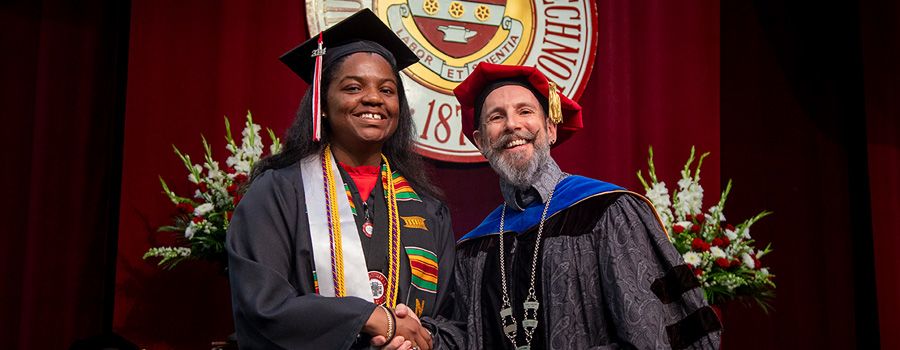
Herman A. Moench Distinguished
Senior Commendation
Commendable influence on the Rose community
Nyomi Morris | Computer Science

Heminway Gold Medal
Highest academic achievement
Olivia Davis | Computer Science/Mathematics
Ella Dorfmueller | Chemical Engineering
Michael Fraczek | Biology/Biochemistry and Molecular Biology
Zachary Gault | Computer Science/Software Engineering
Nathan Hurtig | Computer Science/Mathematics
Arjent Imeri | Optical Engineering/Nanoengineering
Andrew Kosikowski | Computer Science/Software Engineering/
Mathematics/Data Science
Yingeng Liu | Computer Science/Data Science
Tracy Orgera | Chemical Engineering
Nathan Quets | Electrical Engineering
Adithya Ramji | Computer Science
Hannah Snider | Chemical Engineering/Chemistry
Liam Waterbury | Software Engineering
Katherine Wood | Civil Engineering

John Swearingen Presented Honorary Doctorate
The numerous career, community, and institutional contributions of 1981 chemical engineering alumnus John Swearingen were recognized with an Honorary Doctor of Engineering degree. He had a successful 39-year career with Marathon Petroleum Corporation, retiring as executive vice president of logistics and storage in 2020.
John and his wife, Anne, have been faithful supporters of Rose-Hulman. They provided a generous donation to establish the Department of Chemical Engineering’s first endowed faculty professorship, along with supporting laboratory and technology modifications for the department. The couple also has supported scholarships and a new leadership series that’s encouraging the development of future leaders in STEM to solve complex problems.
FACULTY/STAFF AWARDS
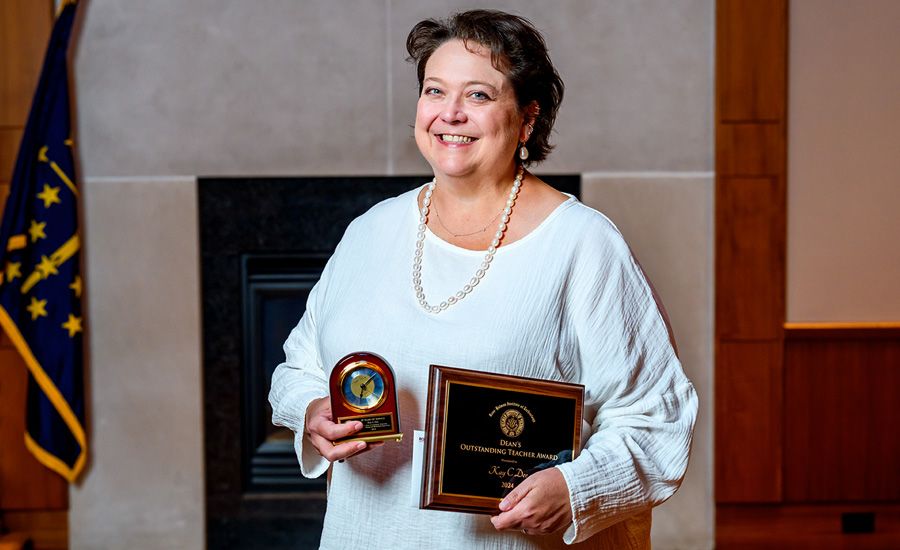
Dean’s Outstanding Teacher
Kay C Dee, PhD | Associate Dean for Learning & Technology/Biology & Biomedical Engineering

Board of Trustees’ Outstanding Scholar
Nate Chenette, PhD | Computer Science & Software Engineering

President’s Outstanding Service
Gary Meyer | Technician/Electrical & Computer Engineering
CAMPUS NEWS
Sports and Recreation Center Getting $5M Expansion

A $5 million expansion to the Sports and Recreation Center, currently underway, will provide additional facilities to meet the rising need for athletic and student recreation services and further enhance the nation’s top-ranked STEM college.
The addition to the east end of the building, overlooking the outdoor Cook Stadium, will have two floors with seven offices, a locker room, an expanded storage area, and a dedicated recruiting room for intercollegiate athletics (bottom image at right). There will also be a large room with flexibility to host large group meetings or student recreational/fitness activities.
Construction is scheduled to be completed by spring 2025. The Sports and Recreation Center served 312 student-athletes and 18 varsity sports in 1997. Today, 27 years later, Rose-Hulman’s 20 sports have more than 600 student-athletes and several more head and assistant coaches, along with additional support staff.
Record ‘Rose Giving Day’ Shows Impact of a Gift on One Day
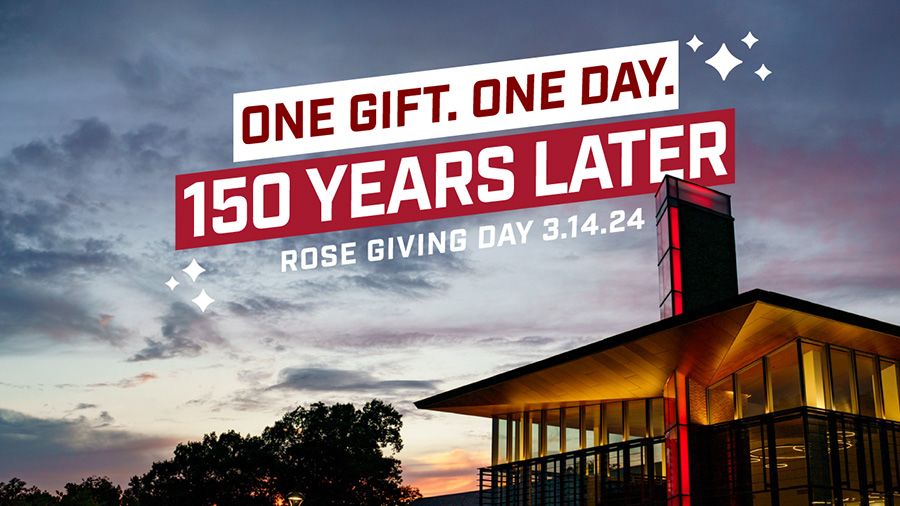
The fifth annual Giving Day was a memorable one this spring, with supporters contributing a record $650,223 through 667 gifts. These donations will help meet the college’s greatest needs, student scholarships, academic programs, student experiences, athletics, and more.
The total raised well exceeded the previous record of $508,607 set in 2023.
Several donors helped spur the giving with matching gift challenges. Those included significant gifts from the Cless Family
in supporting student experiences and services. Susan and Dave Hoecker (ME, 1969) along with Victoria (CS, 2006) and
Matt Ellis (CS, 2005) offered generous matching gifts in support of the college’s greatest needs, while Karen DeGrange, the family of the late Herb Bailey (EE/CHE, 1945), PhD, and Jason Carlyle (MA/CS, 1998) donated to support student scholarships.
Lyle Carlson (CPE, 1991) contributed to cybersecurity initiatives, while the company Kalogon supported student competition teams in the Branam and Kremer Innovation Centers. Brent Mewhinney (EE, 1984) and Dana (CHE/ECON, 2006) and Jon Pierson contributed gifts in support of athletics, while Randy Potts (CHE, 1971) contributed to the ROTC program. Margo and Jack Fenoglio (CHE, 1959), and President Robert A. Coons and his Cabinet also supported the day with matching gifts.
‘Rose Show’ Filled with Entrepreneurship, Sustainability & Innovation Projects

Elements of innovation, entrepreneurship, and sustainability–and sometimes a combination of all three–were showcased throughout more than 100 student projects featured in this spring’s Rose Show, the college’s annual version of the World’s Fair.
Projects completed this school year by first-year students through seniors across all academic areas addressed the needs of companies, organizations, and individual clients through mechanics, artificial intelligence, generative AI, Cloud computing, robotics, gaming, and software programming. Nearly every academic department was represented, including mathematics and humanities, social sciences, and the arts.
The William A. Kline Innovation Award went to StrapTech, a wireless monitoring strap tension device for the trucking industry. Honorable mention awards went to DriveTEK, a portable, flexible driving simulator built to safely study the driving experience; an EcoBlaze chainsaw, designed to help California wildland firefighters; and a physical therapy car simulator for Union Health’s Physical Therapy Laboratory (updating an earlier version originally created by Rose students).
Tech Executive, Entrepreneur Featured in New Swearingen Leadership Series

The new Swearingen Leadership Series had highly decorated STEM education advocate Kate Maxwell and inspiring author/entrepreneur Hank Green providing students with a variety of inspiration messages to follow in their footsteps as technology leaders.
Speaking on International Women’s Day, Maxwell’s “Launch Before You Are Ready” presentation featured such themes as embrace failure; aim for progress, not perfection; invention takes courage; and things are attainable if you stretch and reach for them.
Meanwhile, Green’s quizzical views of the world and science were featured in an engaging, thought-provoking, and entertaining Question-and-Answer session that had students filling the Sports and Recreation Center’s Hulbert Arena as part of the Sesquicentennial Celebration.
John Swearingen (CHE, 1981) and his wife, Anne, established the series to encourage development of future leaders in STEM to solve complex problems.
Rogge Begins New Role as Dean of Faculty

Award-winning biomedical engineering educator and scholar Renee Rogge, PhD, is now in a new role as the Dean of the Faculty, replacing Russ Warley, PhD, who has returned to a faculty role on campus. Rogge has received the Dean’s Outstanding Teacher Award (2018) and Board of Trustees’ Outstanding Scholar Award (2014) and has been recognized nationally as a capstone design instructor since joining the Rose faculty in 2004. She also was the inaugural Samuel F. Hulbert Endowed Faculty Chair
in Biomedical Engineering.
OTHER FACULTY NEWS
• Mario Simoni, PhD, has been reappointed as Head of the Department of Electrical and Computer Engineering. He has led the area since 2016 and been a member of the Rose faculty since 2001.
• Mathematics professor Wayne Tarrant, PhD, is the next Endowed Chair for Innovation in Science, Engineering, and Mathematics Education, also known as the Innovation Chair. Established by a bequest in 2015, the chair recognizes Tarrant’s work as an outstanding teacher and global scholar.
• Chemistry and biochemistry professor Dan Morris is continuing the legacy of one of the Institute’s outstanding educators as the esteemed Herman A. Moench Distinguished Professor, named for the late 1929 alum. Morris has been a faculty member since 1996.
• Carlotta Berry, PhD, has been reappointed the Lawrence J. Giacoletto Endowed Chair in Electrical and Computer Engineering, established to honor the 1938 Rose graduate. Berry has taught robotics and other subjects since 2006.
• Award-winning professors Mark Yoder, PhD, and Thom Adams (ME, 1990), PhD, retired at the end of the 2023-24 school year. Yoder taught
in the Department of Electrical and Computer Engineering for 36 years while Adams was a fixture in the Department of Mechanical Engineering for 25 years.
Community Connections
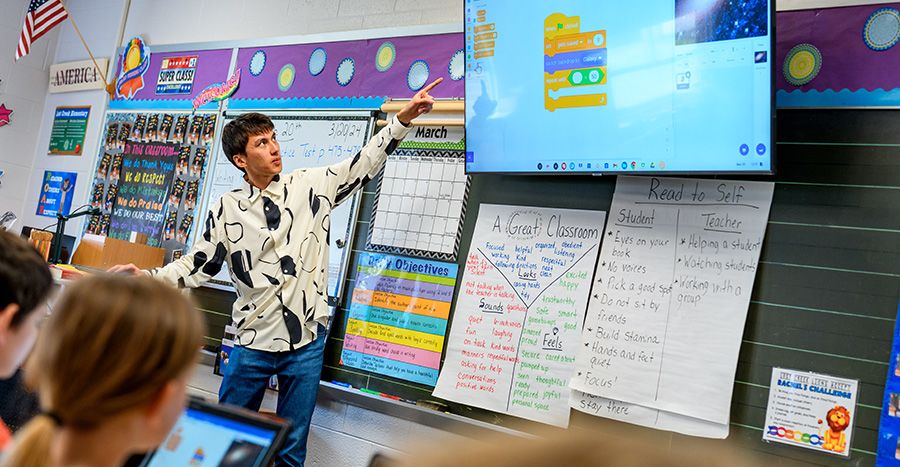
Students Using Computing to Build Local School Partnership
Students have moved to the head of the class to pass along their love of computing and technology onto younger generations through a blossoming educational partnership with two Vigo County School Corporation elementary schools.
A Programming in the Community course led by Computer Science and Software Engineering Professor David Fisher, PhD, (ME, 2000) has small groups of students leading weekly technology sessions in third-, fourth-, and fifth-grade classrooms throughout the school year. The visiting students help mentor the youths on simple exercises and games by using the Scratch programming language. Some of the games have been custom-made for the classrooms.

That was the case on an afternoon this spring, as brothers Brian and Andrew Pascente joined Adam Jirovec, Shaun Yamamoto, and Chris Lardner to meticulously guide 23 kids in a Lost Creek Elementary School third grade class to utilize simple computer programming building blocks to customize aspects of a “Save The Pets” game—selecting a variety of animals, costumes, scenic backgrounds, and sounds.
“The kids love it. They really look forward to seeing what the Rose-Hulman students are going to bring into the classroom each week,” says the class’s teacher Michaela Gauer.
The same sentiment can be found at Terre Town Elementary School, where Naa Ashifia Anum, Nyomi Morris, Endia Clark, and Remi Schwartz introduced fifth graders into simple engineering programming concepts. The Rose-Hulman students took time to help the kids reflect upon their projects, why the computer programs worked (and in some cases didn’t), and how it could be a building block for future projects.
“My goal is to expose the kids to as many disciplines and possible career routes and this was a fabulous introduction to engineering,” remarks teacher Amy Bennett.
Ninety Rose-Hulman students from all class years (senior through freshmen) and a variety of academic majors made 360 visits covering more than 14,000 minutes of programming instruction at the two schools during the 2023-24 school year.
“ Computers and computing are going to be a big part of the (VCSC) students’ world. We want to get them to embrace technology and take advantage of these computing tools that they have at their fingertips.”
Teams, Athletes Have More HCAC, NCAA Successes
Championship seasons by men’s and women’s teams in golf, swimming, and
track and field, along with men’s soccer and tennis helped Rose athletics place first in the Heartland Collegiate Athletic Conference’s 2023-24 men’s all-sports standings and second for this year’s Commissioner’s Cup. The men’s and women’s golf and men’s soccer and tennis teams advanced to their NCAA Division III championship tournaments—only the second time in 26 years for men’s golf.
Featured individual athletic honors this athletic year were:
- Jailen Hobbs (CPE, 2024), Kyle Brownell (CS, 2024) and Tim Youndt (ME, 2024) earned All-American honors for their performances in the NCAA indoor and outdoor national championships. Hobbs placed third in the indoors’ 60-meter dash (with a school-record 6.74 time); Brownell was sixth in the outdoors’ high jump (career-best 6’-9.75”); and Youndt was eighth in the outdoors’ triple jump (career-best 48’-1.75”).
- Junior Vineet Ranade earned second-team All-American honors with
a 16th-place finish in the 200-meter freestyle race (1:39.47) at the
NCAA swimming championships. - Other 2023-24 All-Americans were Caleb Urban (BSCE, 2023/MSCE, 2024) in men's soccer, senior Andrew Toler in football, and junior Kade Kline in baseball.
- Golfer Precious Saelee (EE, 2024) joined Hobbs in receiving Ruel Fox Burns Blankets as the top graduating athletes, based on their outstanding career athletic performances. Saelee was a two-time HCAC Women’s Golfer of the Year and four-time NCAA championship qualifier; Hobbs was Rose’s first two-sport All-American (football and track & field) and HCAC Player of the Year in both sports.
NanoEngineering Enhances Cutting-Edge Programs
The Physics and Optical Engineering Department’s renamed NanoEngineering program is a comprehensive curriculum designed to provide students with a strong foundation in fundamental engineering principles, coupled with a deep focus on nanoscale science and technology,
including essential modeling and simulation techniques.
Students will engage in hands-on research projects, collaborate with leading experts in the field, and have access to state-of-the-art laboratories—such as the Micro-Nanoscale Device and Systems lab—equipped with cutting-edge nanofabrication and characterization tools. The program
will distinguish Rose-Hulman as a leader in preparing the next generation of nanotechnology experts and innovators.
“The NanoEngineering program is not just about staying current; it is about setting the stage for the future,” says Rick Stamper (ME, 1985), PhD, provost and vice president for academic affairs.
Duo Continues Goldwater Scholars Tradition
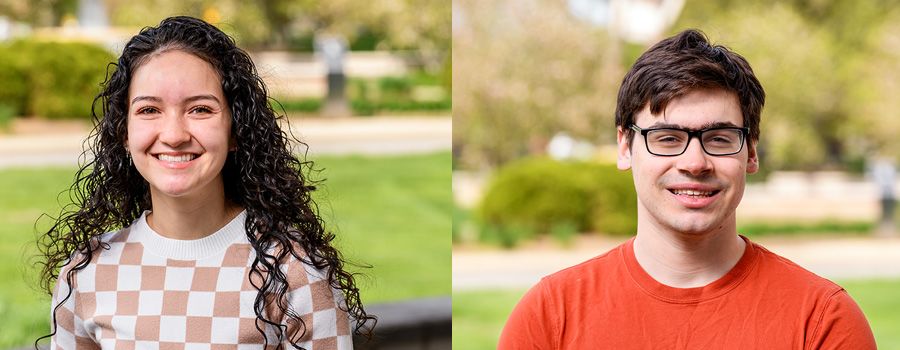
Biomedical engineering major Ellen Shales and mathematics major Connor Lane are the latest Rose students to earn distinction as Goldwater Scholars, the preeminent honor for undergraduate students pursuing doctoral degrees in natural science, engineering, and mathematics.
This marks the fourth consecutive year for Rose to have a Goldwater Scholar, and 17 students have earned the distinction since 2004.
Shales’ research work includes an internship with the University of Wisconsin’s behavioral neuroscience laboratory and work in a synthetic biology lab at Rice University.
Lane has been involved in several campus research projects and is participating in a Research Experiences for Undergraduates program this summer at Clemson University.
Past Rose Goldwater Scholars have become physicians, researchers at world-respected medical research clinics, experts in industry, and students pursuing PhDs at leading universities.
TEDx Event Highlights STEM Connections that Diversify & Impact the World

As part of Rose-Hulman’s International Women’s Day and Women’s History Month celebrations, six women faculty provided thought-provoking TEDx Talks that showcased how the interdisciplinary connections within STEM are helping diversify and impact the world and its people.
Topics featured in the 20-minute talks on the Hatfield Hall Theater stage were “Engineering In Context,” by Irene Reizman, PhD, Alfred R. Schmidt Endowed Chair for Excellence in Teaching/Associate Professor of Chemical Engineering; “Mathematics as a Necessary Tool for Decision Making,” by Lucy Muthoni, PhD, Fulbright Scholar-in-Residence, from Kenya; and “Sustainability in Education: Preparing Future STEM Practitioners for a Changing World,” by Jennifer Mueller, PhD, Associate Professor of Civil and Environmental Engineering.
Also, “Under Pressure,” by Soulaf Abas, Associate Professor of Art; “Science or Art? Why Not Both?”, by Nicole Pfiester, PhD, Assistant Professor in Physics and Optical Engineering; and “Making STEM Steamy: Innovative Strategies to Diversify STEM by Using Art,” by Carlotta Berry, PhD, Professor/Lawrence J. Giacoletto Endowed Chair of Electrical and Computer Engineering.
“Rose-Hulman is the perfect place for people to come together to share engaging ideas that reveal there’s so much more to STEM than just science, technology, engineering, and math,” remarks Berry.
The event, replicating similar presentations in 2017 and 2013, was co-hosted by the college’s Women Faculty Thriving organization and led by Professor of English Jessica Livingston, PhD, and Amanda Jo Hobson, PhD, assistant director of the Office of Diversity, Inclusion, and Belonging.

Students’ Research Helps Bring Promising Shingles Breakthrough for Alum's Firm

Recent chemical engineering graduates Lauren Coffey and Sanya Dronawat were presented with a unique research opportunity as early as their sophomore year–to work on a project that’s contributed to the development of technology showing promise in preventing the painful rash caused by shingles from spreading in human skin.
They spent several weeks in 2022 under the guidance of professors Heather Chenette, PhD, and Irene Reizman, PhD, conducting solubility tests
and experiments on FetTech’s Multi-Tissue Platform (MTP) technology, which was originally developed as a regenerative therapy for wounds and burns. Their tests helped FetTech, a Florida-based biotech startup founded by Clay Fette (CHE, 1999), better understand how to develop a topical gel version of the MTP powder to treat skin conditions.
Recent testing sponsored by the National Institutes of Health has now found the MTP gel and powder to be “highly effective” at halting the spread of the Varicella zoster virus that causes shingles in ex vivo human skin samples even when applied several days after infection occurs.
Fette sees even more possibilities within the department and the Institute’s Rose-Hulman Ventures product research and development firm to involve students in future projects.
Other Student News
- For the first time, the Rose Rocketry Club successfully launched a rocket in the NASA University Student Launch in Huntsville, Alabama, flying to 4,302 feet above the ground—close to its 4,500-foot goal. The rocket carried a five-pound deployable drone.
- Four computer science students placed third in the undergraduate division of the NCAA’s Crossroads Classic Analytics Challenge after examining customer data from past Division I women’s basketball championship sites to create predictive models for games in all rounds of the 2024 tournament.
- The Human Powered Vehicles Team placed second in the American Society of Mechanical Engineering’s eFest eHPV Competition at Liberty University (Virginia). The team was first in the drag race, earned second-place honors for design, and finished third in endurance race.
- The Battery Workforce Challenge Team placed fifth among 12 North American college teams in the first year of the U.S. Department of Energy-sponsored competition that’s developing innovative battery technology for a Stellantis electric van. Students received Best in Class awards for project initiation plan and Best Subject Matter Expert deep dive.
- The Rose Propulsion Laboratory Group, a liquid rocket exploration initiative of the Rose Rocketry Club, is developing elements of self-landing rockets for the Collegiate Propulsive Lander Challenge.




Exemplifying the spirit of service at the heart of the engineering profession, 2009 civil engineering alumna Elizabeth (Beller) Staryak has a deep sense of compassion and a desire to create a better world.
Her commitment is showcased through 14 years of community service with the New York Junior League (NYJI), earning her the organization’s Outstanding Volunteer Award for 2024.
As a director at large of the Junior League’s Board of Directors, Staryak plays a pivotal role in identifying and implementing initiatives, like domestic violence advocacy or adult financial literacy, that create positive change within her hometown. She has been an advocate for survivors of domestic violence and has helped first-generation Americans open credit accounts. Additionally, she has completed two New York City Marathons since 2021 for the NYJL team.
However, Staryak’s passion for service extends to her work with Guiding Eyes for the Blind, a nonprofit organization that provides guide dogs to individuals with vision loss, which is even more inspiring.
Guiding Eyes for the Blind’s mission is to connect exceptional dogs with individuals in need, empowering them with greater independence and mobility. Staryak has taken this mission to heart, dedicating herself to raising her eighth puppy for the program. Her training period with each dog lasts 18 to 24 months. This commitment reflects her profound understanding of the transformative impact these highly trained dogs can have on the lives of those they serve. It’s also how she met her husband, Adam, a fellow guide puppy raiser.
“I spend thousands of hours working to get these dogs ready to make a difference in other’s lives. These aren’t my dogs. They come into my world for a reason—to go out and change their future partner’s life,” she says. “It’s a small way of making the world a better place, which is my goal in my work as an engineer.”
She is also an active supporter of the Wildlife Conservation Society, demonstrating her commitment to preserving the natural world and protecting vulnerable species.
Professionally, Staryak’s engineering expertise shines as a rail and transit senior project manager with STV Inc. Her leadership as the deputy construction manager on the East River Tunnel Rehabilitation project, a $1 billion endeavor, showcases her ability to tackle complex challenges and deliver impactful solutions. This project, which aims to rehabilitate a vital transportation infrastructure hub within New York City, exemplifies Staryak’s dedication to improving countless lives through her engineering prowess.
Through her diverse personal and professional involvements, Staryak epitomizes the engineering code of service, using the knowledge and skills she gained at Rose-Hulman to create positive change in her community. She serves as a reminder of the profound impact that engineers can have when they embrace their calling to improve the lives of others.

CONRAD TUCKER Returns to African Roots to Transform Technological Horizons
With a personal and professional passport filled with stamps from across the world, it’s not surprising that 2004 mechanical engineering alumnus Conrad Tucker, PhD, has become a strong advocate for engineers, scientists, and mathematicians to make a global impact.
That mission has taken him to become director of Carnegie Mellon University-Africa’s campus in Rwanda and associate dean for international programs in Africa for CMU’s College of Engineering. At the same time, he is continuing to lead students from throughout the world in making scholarly achievements in machine learning, neuroscience-inspired artificial intelligence, robotics, and biomedical engineering–technical domains that can help enhance human capabilities.
Started in 2011 under a partnership with the Rwandan government, CMU-Africa offers graduate degrees, as part of CMU’s College of Engineering, in information technology, electrical and computer engineering, and engineering artificial intelligence. Its student body of more than 300 graduate students from 19 nationalities are addressing a critical shortage of creative and technically strong engineering talent for the African workforce–one of the fast-growing workforces in the world.

Tucker says, “I have always loved challenges and the idea of giving back
on a global scale. I see my work at CMU-Africa as a service to the continent. This provides a new dimension of impact. Over the past decade, I have been focused on impact from a research perspective (writing scholarly publications and mentoring master’s and PhD students). This has been very rewarding. However, now I can have an impact on a continental scale by educating the next generation of African leaders and innovators to make a transformative impact in their communities and the world.”
That’s what Tucker has done throughout his own educational journey as the son of a college professor/researcher (father) and elementary school principal (mother). The family escaped internal strife within Sierra Leone along Africa’s western coastline to find refuge in nearby Guinea before eventually moving to America. As a high-achieving high school student in Maryland, Tucker became interested in Rose-Hulman and engineering after enjoying a summer at the college’s Operation Catapult program.

Tucker's interest in engineering was encouraged in hands-on educational opportunities in Rose-Hulman's Operation Catapult and mechanical engineering programs.
Tucker's interest in engineering was encouraged in hands-on educational opportunities in Rose-Hulman's Operation Catapult and mechanical engineering programs.
His interest in engineering grew as a Rose student, learning about elements of mechanical systems and robotics, along with earning a minor in economics. Tucker also became involved in a variety of student activities, enjoyed playing ultimate Frisbee games with classmates on the campus’ front lawn, and
gave back to Terre Haute through community service projects.
“Rose taught me to strive for academic and professional excellence by pushing your limits while providing the important building blocks for the future. There was a sense of community support and encouragement that every student needed, and has helped us succeed as graduates,” he states.
Tucker reconnected with his former Rose academic adviser Rick Stamper (ME, 1985), PhD, (now the institute’s provost and vice president for academic affairs) during a visit to CMU-Africa last fall as the two institutions explore possible future educational partnerships.
Employing artificial intelligence and machine learning techniques in engineering system design, health care, and education has been the focus of Tucker’s role as a researcher while earning a master’s degree and PhD in industrial engineering at the University of Illinois at Urbana-Champaign, along with teaching for eight years at Penn State University, and four in the Department of Mechanical Engineering at Carnegie Mellon.
Along with his director role at CMU-Africa, Tucker teaches and conducts research on machine learning and directs the Artificial Intelligence in Products Engineered for X Laboratory (AiPEX Lab) at Carnegie Mellon’s Pittsburgh campus. Rose-Hulman alumni Jiatong Zhang (ME, 2021) and Songwei Fan (ME, 2022) have been enrolled in Tucker’s Machine Learning and Artificial Intelligence for Engineers course. His research and education goals are tightly integrated and focus on advancing personalization, both from a design and learning perspective.
“We’re experiencing a monumental paradigm shift in technology, not only in the innovations of these technologies but the speed of which they are progressing,” he says. “Where we’re going is up to us as researchers and decision-makers — to decide how these technologies are going to be used or integrated to impact people’s lives ... The path of a researcher and educator is not just to give back knowledge to students, but to engage in research that you’re hoping will transform the world and have a global impact.”
“I have always loved challenges and the idea
of giving back on a global scale. I see my work at
CMU-Africa as a service to the continent. This provides a new dimension of impact.”
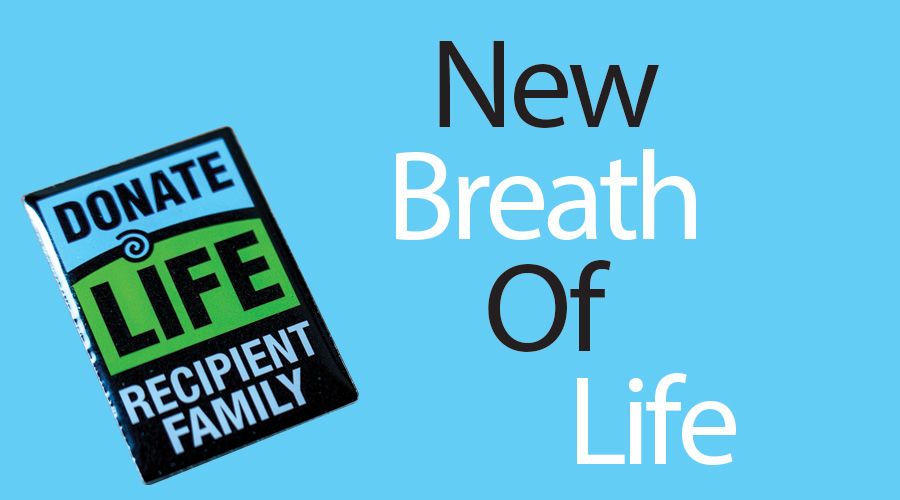
Eric Sheets Counting Blessings After Lung Transplant
Eric Sheets took several deep breaths while recounting the details of an inspirational five-year journey that was filled with gratitude, perseverance, love, and personal reflection — for himself and several others that benefitted from someone else’s selfless gift.
After all, there was a time when the 1983 mechanical engineering graduate was a fixture of good health as a former Fightin’ Engineer basketball player and recreational cyclist.
Then, every breath became a struggle.
The effects of pulmonary fibrosis deteriorated Eric’s lung capacity to such a state that he couldn’t perform a simple breathing test, his listless body could hardly move around his home in Greenwood, Indiana, and he needed to take a leave of absence as an experimental test engineer with Rolls-Royce Corporation — his career for 38 years. He had developed a wicked cough, lost his appetite (dropping 30 pounds within nine months), and his fingertips had taken on a bluish hue from oxygen deprivation within his blood stream.
“I used to love taking long hikes with Stephanie (his wife) at state and national parks, admiring the beautiful scenery and wonders of nature. I’d take bike rides with my three sons and really liked coaching a homeschool basketball team. Then, over the course of three years and without any rhyme or reason, I went to being constantly out of breath, gasping for air, and became a shell of my old, happy self,” Eric recalls.
Then, the conversation took on a serious tone as the 62-year-old states, “I was a dead man walking.”
A double-lung transplant through the Indiana Donor Network and doctors at Indianapolis’ Methodist Hospital was the only solution. He was considered a “perfect” recipient, with no past health problems.
“All that I had was a bad set of lungs,” Eric says.
Now all he needed was the “perfect” donor.
That happened on November 30, 2018, after the death of Chase Crompvoets, an athletic California 18-year-old who had been attending Chicago’s DePaul University, following a seizure.
At the same time, lying in the hospital bed was Eric with Stephanie, a former Rose-Hulman cheerleader, nearby as a constant, loving companion. The couple and other family members had been through the emotional rollercoaster of possibly finding a prospective donor just three weeks earlier.
And they knew that there might not be another chance.
Chase’s lungs arrived and surgery started in the early morning hours of December 1 with a team of doctors and staff working feverishly to make the successful transplant. Every second mattered.
A day and a half later, Eric was wide awake and breathing on his own. He soon had enough energy to start taking daily walks around the hospital, building up his stamina each day.
“Within minutes (after the surgery), I immediately noticed more of a natural color coming back to his fingers and lips. He was returning to me,” said Stephanie.
Eric left the hospital on December 18 and began physical therapy and a constant watch on whether his body would accept Chase’s gift of life.
Soon after arriving home from the ordeal, Eric wrote a Thank You letter to the Indiana Donor Network in hopes that it would get to anyone associated with the donor. “The Network passes along any letters, but there are no guarantees that anything will come from them. I understood that, but I just needed to express my sincere gratitude and report that their loss, however tragic, had helped give life to another. We were so grateful.”
Two other letters followed before a response finally came from Chase’s mother, Kelly Crompvoets, nearly four years after the transplant (December of 2022). The correspondence started with the heart-felt sentiment: “I have been trying to write this letter for four years …”
Then in February of 2023, Eric and Stephanie traveled to California to meet Chase’s family. The special reunion took place in the family’s home, surrounded by photos and memories of a teenager who had registered as an organ donor (unbeknownst to his family).
“Everything about our time together was surreal,” Eric recalls. “We wanted to know everything about Chase, and they were happy to oblige. We found out what a special young man he was. And they were so happy to see that I was doing so well.”
This is a special feel-good human interest story — one that’s been featured in the Indianapolis Star and other newspapers throughout the country. Eric and Stephanie now tell their inspirational story at church, college, and community events throughout the state in support of the Indiana Donor Network. They hope that more lives are saved by others on donor registries throughout the country. (Chase’s heart was given to a young mother of two boys in her final stages of congenital heart disease; his liver went to another patient, and his kidneys were donated to two different people. All those recipients are still alive today.)
“I believe there’s a reason why I’m still here and able to enjoy my wonderful life. It’s divine intervention along with the support of family, friends, doctors, nurses, and physical therapists. And there was a lot of medical technology, created by engineers and scientists, that contributed to my well-being. I’m a very fortunate man who has a new zest for life.”
“I believe there’s a reason why I’m still here and able to enjoy my wonderful life ... I’m a very fortunate man who has a new zest for life.”

Four years after the lung donation, the Sheets traveled to California to thank the family of donor Chase Crompvoets.
Four years after the lung donation, the Sheets traveled to California to thank the family of donor Chase Crompvoets.
CARING HANDS
Gary Ulrich’s Medical Skills Make a Difference in Remote Sudan Area
Gary Ulrich volunteered his orthopedic medicine skills during a two-month medical journey to help patients at Mother of Mercy Hospital in the remote Nuba Mountains region of Sudan in Africa.
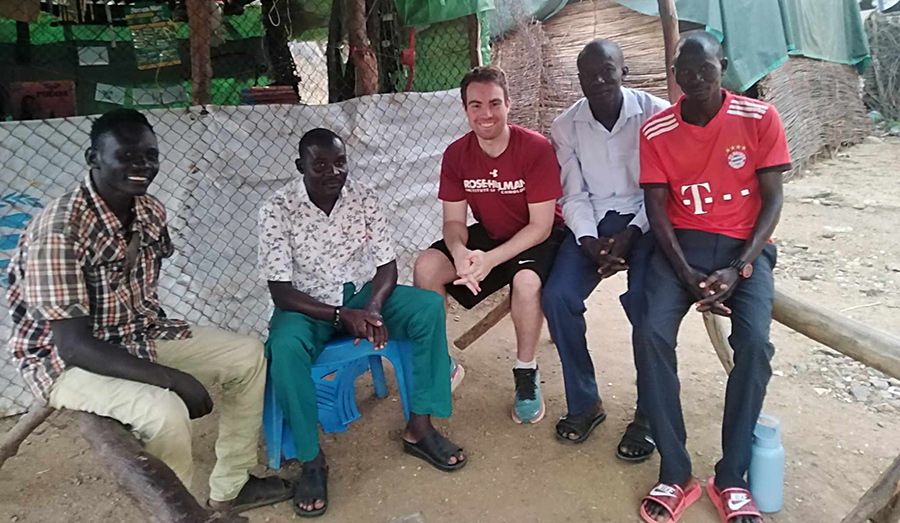
Living the principles of the medical profession’s Hippocratic Oath, Gary Ulrich, MD used his medical and engineering skills to help forgotten people residing within the depths of the war-torn Nuba Mountains region of Africa’s Sudan countryside. Ulrich, a 2017 biology alumnus, spent two months on a volunteer medical journey that changed his outlook on medicine and humanity..
It can take up to two days to make the 20-mile trek on pothole-covered dirt roads from Sudan’s capital city to the mountainous village of Gidel. The area is so remote that COVID-19—the virus that seemed to be everywhere—did not make it to this part of the world.
A bright spot within the region is Mother of Mercy Hospital, led by its lone doctor, Tom Catena, MD, whose life’s mission has been to serve the needs of
the region’s 1.3 million people.
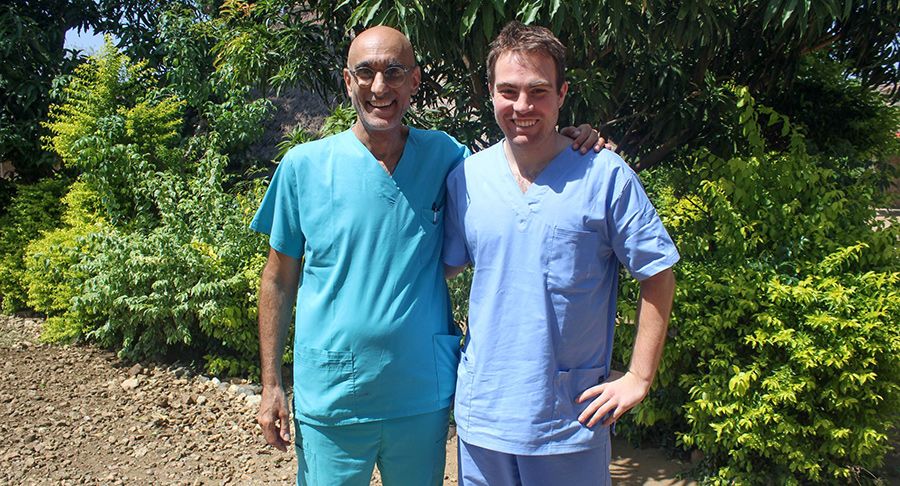
A presentation at Rose-Hulman inspired Gary Ulrich (right) to join Tom Catena's medical humanitarian efforts in Africa.
A presentation at Rose-Hulman inspired Gary Ulrich (right) to join Tom Catena's medical humanitarian efforts in Africa.
Ulrich was inspired to join Catena and his work after hearing about the Mother of Mercy Hospital during a presentation in Rose-Hulman’s Hatfield Hall Theater in 2019. Catena was recognized for his life’s work by Terre Haute’s Union Health system, where he completed a family medicine residency in 1999.
“Hearing his selfless life work inspired me,” says Ulrich. “And I think it’s important to challenge yourself and put yourself in uncomfortable situations to grow and become more well-rounded.”
Ulrich’s two months in Sudan were filled with hands-on physician work and learning how special it is to be a doctor and master a craft (orthopedics) that can impact people’s lives.
In one case, he helped save the leg of a Sudanese People’s Liberation Army soldier who had sustained a severe gunshot wound while fighting for his Nuba homeland.
“In the United States, with an open gunshot wound, the protocol is that antibiotics and a tetanus shot are given within three hours,” Ulrich recalls. “Dr. Catena’s breadth of what he can do is below the knee amputation, which is what this soldier was facing. But I had some experience with orthopedic rotations, and I offered to do a primitive orthopedic surgery to save the leg.”
Ulrich’s external fixation procedure called for metal pins to be inserted into the bone above and below the injury location. These pins were then attached to a metal bar outside the body, and the external fixator frame kept the injured bone stable and aligned throughout the healing process. Additionally, Bill Rhodes, MD, a visiting plastic surgeon from Kenya, performed a cross-leg flap, which involved covering the open gunshot wound with healthy tissue from
the patient’s uninjured leg.

This was the first external fixation procedure completed at Mother of Mercy Hospital. The soldier has since healed and has regained full use of his leg.
The lack of CT scans and MRI machines at the Mother of Mercy Hospital (common equipment at United States’ hospitals) meant that Catena and Ulrich had to rely heavily on hands-on patient examinations. This further improved Ulrich’s diagnostic skills, and he was able to practice orthopedic procedures in a new way.
“The orthopedic breadth of what we can do over there is very limited,” remarks Ulrich. “The sterilization techniques are not up to par; so, if someone needs orthopedic work, we can use plates and screws for fractures. But replacement surgery is not something that’s been tackled. The most common viable option is amputation.”
Ulrich always knew he wanted to be a physician. As the son of a retired orthopedist, he grew up seeing the impact a physician can have within a community. Ulrich chose Rose and its biology program because the college’s rigorous education would be ideal preparation for medical school. He also feels Rose-Hulman ingrained in him qualities of perseverance and integrity along with a strong work ethic that have prepared him for a medical career and life.
After graduation, he earned a medical degree from Indiana University’s School of Medicine and has started a one-year surgical internship this year at the University of Toledo’s Medical Center.
During medical school, Ulrich spent a summer in Leeds, England, learning about the development of modern total hip replacement techniques and was part of a surgical team that replaced a woman’s hip. She was up and walking pain free within a day after the surgery.
“That experience is when it clicked for me that our craft can change lives,” states Ulrich. “Seeing that impact on my own really convinced me to be an orthopedic surgeon.”
Eventually, Ulrich would like to continue incorporating global outreach and service into his orthopedic practice.
“Sometimes people view service work primarily from the perspective that you are doing a good deed for the people you are helping. … But for me, it’s the opposite,” says Ulrich. “Being in the presence of the Nuba people has taught me so much. I have undoubtedly become more grateful and humble with what I have been given in my life … to witness the perseverance of the Nuba people and the selfless life work of Dr. Catena has been an honor.”
“Being in the presence of the Nuba people has taught me so much. I have undoubtedly become more grateful and humble with what I have been given in my life.”
Baker, Thomas Discover New Value Consulting Approach
After nearly three decades on parallel career paths in industries like pharmaceuticals and utilities, 1992 chemistry graduate Tom Baker and 1989 electrical engineering alum Patrick Thomas have joined forces and thought processes in an unconventional consulting firm, Pathom Inc. The firm is pioneering a Value Discovery Methodology approach that brings innovative solutions for a growing list of clients worldwide.
Their quick understanding of each client’s situation through intensive observation, data analysis, and hands-on experimentation allows them to rapidly pinpoint and test potential solutions before deciding on the most impactful options. Pathom’s structured problem-solving processes has roots in Lean Six Sigma and integrates concepts from the science and psychology of creativity and innovation, like understanding cognitive bias.
“Value Discovery is designed to efficiently get low-cost, low-risk solutions that maximize value,” says Thomas, the company’s president and holder of 17 patents. “We love applying this approach in new ways. Sometimes it really challenges the robustness of our approach.”
Baker, the chief executive officer, adds, “There’s a different way to consult that avoids the massive capital outlays, uncertainties, and standardized solutions associated with traditional consulting. Our methodology embraces more of a venture capital-style approach to deliver realistic, achievable ideas with maximum payoff at low cost and risk to the client.”
Pathom cites more than 1,300 occasions where their real-world solutions have delivered $514 million in value to clients in 33 countries.
For instance, the company’s Life Highlights visual tool is helping skilled nursing home facilities provide person-centered, high-quality medical care for senior citizens impaired by Alzheimer’s. Baker comments, “My mother struggled with dementia for five years. Life Highlights will make the world a better place for seniors in care.”
By observing workflows and understanding a U.S. protein producer’s company culture, the alumni duo uncovered ideas that boosted productivity by $16 million. In another case, they accelerated the launch of a utility company’s continuous improvement program, which was falling behind schedule. Pathom’s analysis revealed ways to increase the program’s pace, quality, and engagement, generating hundreds of new improvement ideas.
Additionally, Thomas and Baker used thermal imaging and experiments with local materials to create micro-climate solutions, allowing poultry farmers in India to better control living conditions for their flocks. This improved the farmers’ quality of life by eliminating the need to constantly stay with the birds.
By combining technical knowledge from their Rose education with insights gained across multiple industries over decades, Baker and Thomas are pioneering a nimbler, more cost-effective approach to tackling business challenges. Their passion remains making things better through an entrepreneurial lens on strategic change.





